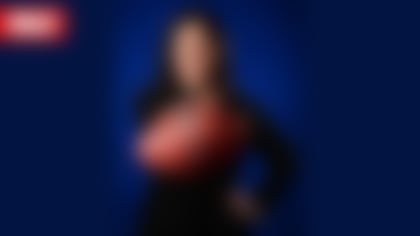Women are rising up the ranks throughout professional football, earning positions of power in a space that for too long was ruled almost exclusively by men. We're seeing more and more women breaking barriers in the sport, but what are the stories beyond the headlines? Who are the women shaping and influencing the NFL today? Answering those questions is the aim of the Next Woman Up series. While the conversational Q&As are edited and condensed for clarity, this is a forum for impactful women to share experiences in their own words. Without further ado, we introduce:
Charlotte Jones, Dallas Cowboys
Position: Executive Vice President and Chief Brand Officer
* * * * *
You've been around the NFL since at least 1989 (when the Jones family bought the Dallas Cowboys). How did you specifically get your start in a career in the NFL?
I never actually thought I'd be in the world of sports. I went into politics, moved to Washington D.C. and was working there when my dad had this harebrained idea of buying the Dallas Cowboys. It was the only time my dad has underestimated anything he ever told us. And he said at that time, "You know, if we do this, this just may change our life a little."
He always had this huge passion for sports and suddenly came this opportunity to buy the team. Literally none of his financial advisors suggested he do this because the team was losing around $75,000 a day and over a million each month. The team just went 3-13 in 1988, and there was a reason why they were for sale. It was really a mess on paper.
My dad went to Dallas and [one of the first calls] I get, he said, "Do you know what hot pants are?" And I'm like, "Oh my gosh. What?!" He repeated it and told me there was a line of women outside his office telling him that he was trying to change the iconic Cowboys cheerleader uniforms from hot pants to biker shorts. He didn't know the difference and needed help. I have a background in cheer and dance, so I went down to Dallas and we figured out it was a rumor. But while I was down there, he asked me to stay. I told him, "I don't know anything about running a professional football team." He said, "That's OK. Neither do I. I just need people around me that I can trust and who will be as passionate as I am and can help find ways to make this organization successful."
When I got to Dallas ... he said, "Two things: Find a way to stop losing money, and whatever you do, don't tarnish the Star." That was it. That became my only guidance. What became super clear at that moment was that he knew he had an amazing brand and an amazing sports entity that was truly valued by people and revered by all of these fans, but somehow, we had to get it back on track.
It turns out our biggest expense by far was training camp. The Cowboys had it out in Thousand Oaks (California) under coach Tom Landry, but it was a huge expense to move the whole team out here for a month and move everyone back. So I thought, What if we train closer to home and go to Austin? New coach Jimmy Johnson was all about conditioning with the heat, so he was all for it.
My job was to set up the deal with St. Edward's University in Austin and figure out how to set up a camp. Honestly, I didn't actually know how to set up a camp, so again, I went through all the expenses and realized how expensive it was to clean the laundry. So the first thing I did was go to laundromats and asked if they'd do our laundry for free in exchange for advertising at camp. One person said "yes," then the next person said "yes," and the next person until I literally bartered the expenses out of camp.
I really, honestly didn't know what I was doing, but I had to figure something out. I had a lot of really bad ideas, but learned from them and kept pushing forward.
What an unforgettable way to start your career. You mentioned the challenges you faced back then, but when you look across the board to present day, what would you say is the biggest challenge of your position?
Our game has always been about tradition, and we came in knowing how sensitive and important that is. But if you stay generational, you become nostalgic. So how do you honor that tradition but still remain relevant? How do we meet our new audiences, whose time is being pulled in a million directions, and drive the game forward and bring it into our next realm into the generation?
In tandem with that, for us, our greatest competition isn't the Eagles or the Giants or the Washington Football Team. It's actually the home theater. There's an enormous audience sitting at home and screens are getting bigger. How do you actually get those people out of the comforts of their home and into your stadium? I once heard an announcer say, "The greatest thing about watching our game on television is wishing you were there." We've seen that more defined over the last year without fans in the stands.
One of my biggest fears -- if the pandemic softens, of course -- is wondering if people will return to the stadium. When you think, I've gotta have that coffee every morning ... But if you go a year without it, do you really need it? We're finding the answer is yes in terms of our sport. People want to be all in, and that is reassuring. But it reminds us how precious our fans and avidity are because we really aren't a brand. We're a culture.

Let's talk a little bit more about the brand. What has been your biggest project?
My first true project was AT&T Stadium -- designing it, building it and recognizing the need of what the next generation of stadiums should deliver. Steve Wynn has a Picasso museum with incredible art everywhere in one of his hotels in Las Vegas that has nothing to do with game play. I asked him, why put that huge investment in when he could just stand up that casino and print cash? His reply was, "If you show your patrons that you value them and are willing to invest in them, they will patron you forever." That's the approach we took with the stadium, and it's why you can't decide if you're at a stadium, a Ritz lobby or an art museum. The stadium could've been built for $700 million, and we spent double. All of it was for that "wow" factor, so our fans feel valued there beyond the game.
Second is our building of The Star. As soon as the stadium was done, I don't know if I looked bored or something, but we went back to our training facilities and were like, "Well, this is not shiny and new." Then we had an incredible opportunity to partner with high school football. In the city of Frisco, they were looking to build a singular, large stadium for all of their high schools. And they thought, if they could partner with us, we would build them a better one. We did. We moved our headquarters to Frisco and our practice facility is the city of Frisco's high school stadium: a 15,000-seat indoor stadium. Our offices are there. We brought in our partners and developed the area into a restaurant, retail and hotel extravaganza. It truly is our Disney World.
And what are you most proud of?
Our ongoing association with the Salvation Army. In the early 1990s, coming off two Super Bowl wins, we realized if people were as interested with what we were doing away from the field as much as they were on it, maybe we could understand the connection, use it and partner with an organization that is truly making an impact and difference. So we partnered with the Salvation Army, a group that was all about humility and helping people but wasn't necessarily concerned with visibility. So every year on Thanksgiving, we launch a national campaign, and now we've really figured out the puzzle pieces to making an impact. That game has the next-most-visible halftime show after the Super Bowl in our league. Because of that outreach, we are entering our 25th year of that partnership and have raised over $2.7 billion. That is powerful -- and the thing I'm most proud of.

Lastly, having over 30 years of working experience in the NFL, what advice do you have for a female considering a career in football?
In this realm, there are a lot of visible examples now. One of the greatest pieces of advice that I've ever received was from (former Secretary of State) Condoleezza Rice, when she said something along the lines of, "If I had been waiting for a mentor that looked like me, I'd still be waiting." Beyond our own emotional barriers -- sometimes I think we look in the mirror and are our toughest critics about what we can and cannot do -- and with the physical barriers that are coming down, hopefully society is opening that door for us to be part of this incredible sport at any level.
My dad told me long ago, "You do look different than everyone else in this boardroom, but don't try to be everyone else in this boardroom. You need to be here to bring that different opinion, and we need to know what you're thinking and be able to understand, so we can have a better engagement for all of our fans."
We just need one person to know we can do this. Just one cheerleader. And I was fortunate enough to have a father that believed I could be the president of the United States if I wanted to be. He always told me never to lose my best asset, and my best asset is my femininity, knowing my voice and using that voice. I've seen our marketplace acknowledge and react to that in the hiring process across the league, and I think that will continue to grow. I hope young girls look at anyone -- not just other females -- in the league and say, "I can be that."













